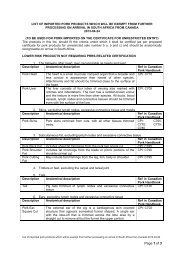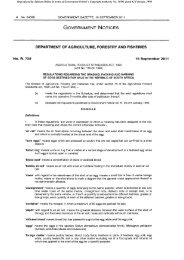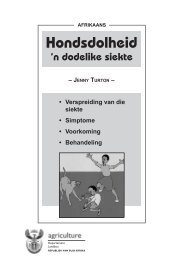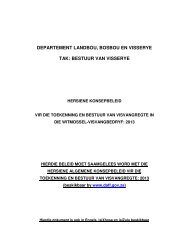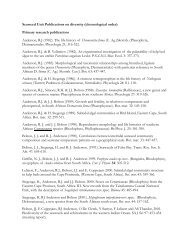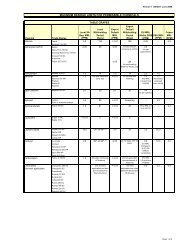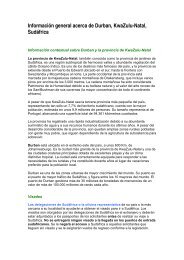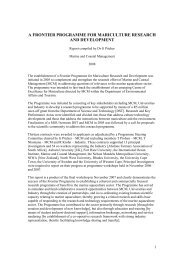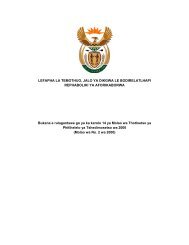You also want an ePaper? Increase the reach of your titles
YUMPU automatically turns print PDFs into web optimized ePapers that Google loves.
Cowries occur mainly on rocky reefs on the east coast, down<br />
to depths of 400 m. Most cowries emerge at night to feed on<br />
algae, sponges and small animals. The spire of the cowrie is<br />
internal and the narrow reinforced aperture together with the<br />
glossy surface make it very difficult for a crab to grip, let<br />
alone break open. They do, however, fall prey to octopuses<br />
that can grip the shell and drill a hole in it using powerful<br />
beaks. Bottom-dwelling fish also swallow cowries,<br />
and many interesting and rare specimens have<br />
been collected from the guts of fish.<br />
Cones Cones are warm-water species found<br />
on the east coast and in Mozambique. Live cones should<br />
be handled with care as they harpoon their prey with<br />
venomous darts. Large fish-eating species may even<br />
be lethal to man.<br />
Bivalves are filter feeders Bivalves have two shell<br />
valves that are hinged together. They have limited<br />
mobility with no head and nearly all of them filter<br />
particles of food from the water as it passes through<br />
their large gills. Several species such as rock mussels,<br />
oysters, sand mussels and clams are economically<br />
important. The black Mediterranean mussel, a recent<br />
introduction from Europe, is now the dominant inter-<br />
tidal mussel throughout the west coast where, in<br />
places, it is so common that shells are cast up in banks<br />
over a metre deep. Some of the most attractive or unusual<br />
bivalves that bury in sand and mud are the pink Port Alfred<br />
tellin, the colourful scallop, the elongated pencil bait and the<br />
enormous horse mussel (up to 39 cm). Dwarf fans and angel<br />
wings can swim by clapping their shells together.<br />
Chitons – armadillos Chitons are flat oval animals that<br />
have eight overlapping shells. The individual shells are saddle-<br />
shaped and the end shells may look like a set of tiny false teeth.<br />
Preparation and preservation<br />
The removal of the soft parts of bivalves can be achieved by<br />
soaking them in tap water until the shells gape and the animals<br />
can be scraped out. Coiled shells (but not glossy or colourful<br />
ones) can be slowly brought to the boil and the soft parts<br />
hooked out. A good method is to freeze the shell as it pre s e r v e s<br />
the flesh in a form suitable for genetic analysis. The animal<br />
can be thawed slowly in the fridge and the body cont e n t s<br />
hooked out of the shell and eaten or re f rozen. The animal can<br />
also be fixed in alcohol or formalin but it must be stored in<br />
Cone shell<br />
Angel wings<br />
Chiton<br />
alcohol. To prevent chitons from curling up<br />
they should be relaxed and strapped to a<br />
strip of wood as they dry. The surface of a<br />
shell can be cleaned by boiling, or soaking<br />
it in a weak solution of bleach and then<br />
carefully prising off any barnacles, seaweed etc.<br />
How to look after a shell collection<br />
Shells will fade if stored in the light. If your<br />
collection is to have any scientific value the<br />
shells should be labelled with the exact locality<br />
and region of collection, the habitat, collector's<br />
name and date. The name of the shell can be<br />
added later.<br />
Regulations<br />
Never be greedy about collecting live shells,<br />
particularly rare species. It is important to<br />
know the regulations before collecting shells, as<br />
a permit may be required.<br />
Author: Margo Branch September 2000<br />
Classification:<br />
PHYLUM: Brachiopoda – Lamp shells<br />
PHYLUM: Mollusca<br />
CLASS: Polyplacophora – Chitons<br />
CLASS: Bivalvia – Mussels, oysters, clams<br />
CLASS: Scaphopoda – Tusk shells<br />
CLASS: Gastropoda – Winkles, whelks, limpets,<br />
sea slugs<br />
CLASS: Cephalopoda – Cuttlefish, paper nautilus,<br />
ram's horn shell, octopus, squid.<br />
FURTHER INFORMATION:<br />
• The Conchological Society of Southern Africa, 7 Jan Booysen St., Annlin, Pretoria 0182.<br />
• Museums in Durban, Mossel Bay and Cape Town • Kilburn, R. & Rippey, E. 1982. Sea Shells of southern Africa. Macmillan South Africa, Johannesburg.<br />
• Richards, D. 1981. South African Shells. Struik, Cape Town. • Steyn, D. G. & Lassi, M. 1998. Marine Shells of South Africa. Ekogilde, Hartbeespoort, South Africa<br />
RELATED FACTSHEETS:<br />
• Gastropods • <strong>Abalone</strong> • Chitons • Bivalves • Sustainable Use of Coastal Resources • Mariculture • Cephalopods • Rock Pools<br />
For more information, please contact: The Coastal Management Office, Marine and Coastal Management, Department of Environmental Affairs and Tourism, Private Bag X2,<br />
Roggebaai 8012, Cape Town, South Africa. Tel: +27 (0)21 402-3208 Fax: +27 (0)21 418-2582 e-mail: czm@mcm.wcape.gov.za Website: http://sacoast.wcape.gov. z a





